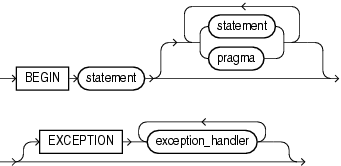| Oracle® Database PL/SQL Language Reference 11g Release 2 (11.2) Part Number E10472-02 |
|
|
View PDF |
| Oracle® Database PL/SQL Language Reference 11g Release 2 (11.2) Part Number E10472-02 |
|
|
View PDF |
The CREATE PACKAGE BODY statement creates or replaces the body of a stored package, which is an encapsulated collection of related procedures, stored functions, and other program objects stored as a unit in the database. The package body defines these objects. The package specification, defined in an earlier CREATE PACKAGE statement, declares these objects.
Packages are an alternative to creating procedures and functions as standalone schema objects.
Topics:
Prerequisites
To create or replace a package in your own schema, you must have the CREATE PROCEDURE system privilege. To create or replace a package in another user's schema, you must have the CREATE ANY PROCEDURE system privilege. In both cases, the package body must be created in the same schema as the package.
To embed a CREATE PACKAGE BODY statement inside an the database precompiler program, you must terminate the statement with the keyword END-EXEC followed by the embedded SQL statement terminator for the specific language.
Syntax
create_package_body ::=

See declare_section ::=.
initialize_section ::=

Semantics
OR REPLACE
Re-creates the package body if it exists, and recompiles it.
Users who were granted privileges on the package body before it was redefined can still access the package without being regranted the privileges.
schema
The name of the schema containing the package. The default is your own schema.
package_name
The name of the package to be created.
declare_section
Declares package objects.
initialize_section
Initializes package variables and does any other one-time setup steps.
body
Defines package objects.
Examples
Creating a Package Body: Example This statement creates the body of the emp_mgmt package created in "Creating a Package: Example".
CREATE OR REPLACE PACKAGE BODY emp_mgmt AS
tot_emps NUMBER;
tot_depts NUMBER;
FUNCTION hire
(last_name VARCHAR2, job_id VARCHAR2,
manager_id NUMBER, salary NUMBER,
commission_pct NUMBER, department_id NUMBER)
RETURN NUMBER IS new_empno NUMBER;
BEGIN
SELECT employees_seq.NEXTVAL
INTO new_empno
FROM DUAL;
INSERT INTO employees
VALUES (new_empno, 'First', 'Last','first.example@oracle.com',
'(415)555-0100','18-JUN-02','IT_PROG',90000000,00,
100,110);
tot_emps := tot_emps + 1;
RETURN(new_empno);
END;
FUNCTION create_dept(department_id NUMBER, location_id NUMBER)
RETURN NUMBER IS
new_deptno NUMBER;
BEGIN
SELECT departments_seq.NEXTVAL
INTO new_deptno
FROM dual;
INSERT INTO departments
VALUES (new_deptno, 'department name', 100, 1700);
tot_depts := tot_depts + 1;
RETURN(new_deptno);
END;
PROCEDURE remove_emp (employee_id NUMBER) IS
BEGIN
DELETE FROM employees
WHERE employees.employee_id = remove_emp.employee_id;
tot_emps := tot_emps - 1;
END;
PROCEDURE remove_dept(department_id NUMBER) IS
BEGIN
DELETE FROM departments
WHERE departments.department_id = remove_dept.department_id;
tot_depts := tot_depts - 1;
SELECT COUNT(*) INTO tot_emps FROM employees;
END;
PROCEDURE increase_sal(employee_id NUMBER, salary_incr NUMBER) IS
curr_sal NUMBER;
BEGIN
SELECT salary INTO curr_sal FROM employees
WHERE employees.employee_id = increase_sal.employee_id;
IF curr_sal IS NULL
THEN RAISE no_sal;
ELSE
UPDATE employees
SET salary = salary + salary_incr
WHERE employee_id = employee_id;
END IF;
END;
PROCEDURE increase_comm(employee_id NUMBER, comm_incr NUMBER) IS
curr_comm NUMBER;
BEGIN
SELECT commission_pct
INTO curr_comm
FROM employees
WHERE employees.employee_id = increase_comm.employee_id;
IF curr_comm IS NULL
THEN RAISE no_comm;
ELSE
UPDATE employees
SET commission_pct = commission_pct + comm_incr;
END IF;
END;
END emp_mgmt;
/
The package body defines the public program objects declared in the package specification:
The functions hire and create_dept
The procedures remove_emp, remove_dept, increase_sal, and increase_comm
These objects are declared in the package specification, so they can be called by application programs, procedures, and functions outside the package. For example, if you have access to the package, you can create a procedure increase_all_comms separate from the emp_mgmt package that calls the increase_comm procedure.
These objects are defined in the package body, so you can change their definitions without causing the database to invalidate dependent schema objects. For example, if you subsequently change the definition of hire, then the database need not recompile increase_all_comms before running it.
The package body in this example also declares private program objects, the variables tot_emps and tot_depts. These objects are declared in the package body rather than the package specification, so they are accessible to other objects in the package, but they are not accessible outside the package. For example, you cannot develop an application that explicitly changes the value of the variable tot_depts. However, the function create_dept is part of the package, so create_dept can change the value of tot_depts.
Related Topics
In this chapter:
In other chapters: